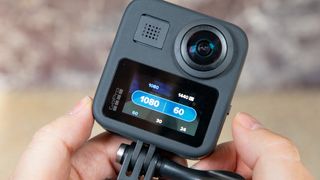Why you can trust TechRadar
Interface
- Touchscreen
- 3 shooting modes
- Shot presets
- On-screen settings
The new 1.7-inch color touchscreen on the GoPro Max makes it much simpler to navigate between shooting modes and sift through device settings. Like the Hero 8 Black, the Max is broken up into three shooting modes: Photo, Video and Time Lapse. You can cycle through these modes by either pushing a physical button on the side of the camera or by swiping left and right on the touchscreen. If you swipe up from the bottom you’ll get access to any clips or shots stored on the camera, while swiping down from the top of the screen will reveal a menu tab for device settings.
The interface is almost identical to what’s on the Hero 8 Black, so the most important picture quality adjustments for each mode are available directly on the shooting screen. There are four icon slots available for quick settings and each can be customized for whatever you need quick access to. GoPro will include any essentials by default like, say, swapping between 3D spherical and 2D Hero digital lenses or flicking between the front and rear cameras when shooting 2D footage, but there’s at least 10 others to choose from, for a more tailored workflow.

In addition to these on-screen shortcuts, the Max also has customizable shooting presets. These are a big feature on the Hero 8 Black as they allow you to pre-configure the ideal settings for different shots, or shooting conditions, and swap between them by opening the toggle at the bottom edge of the screen. While the Max does get this same preset functionality, at the time of writing there was no option to add additional custom presets to the list, which meant that, in most cases, you have to dig into the settings to change anything. Since there is less variability in shooting styles on the Max, this isn’t as big a deal, but it is still a great feature of the Hero 8 Black that seems to be undercooked on the Max.
The settings draw, which drops down when you swipe from the top of the screen, has six quick access options and an in-depth device preferences sub menu making it as easy as possible to access what you need often without losing deeper functionality. These quick settings toggle clever features like quick record, which will turn the camera on and immediately take video in the last shooting preset if the record button is pushed from an off state, and there’s also playback volume, rotation lock, voice commands and screen grid overlay settings available in the initial quick select menu.
Overall, the interface isn’t as full featured as the Hero 8 Black, but it is still really easy to navigate and includes a number of well thought-out features that make it easy to use in the field.
GoPro App
- Integrated new app
- Reframe 360 video editing
- Quik movie features
If you have an iPhone, Android or Mac computer, then you’re going to have access to the new fully-integrated GoPro application. The updated app will take you all the way from the raw, imported clip to published product in under 30 minutes, and requires no additional editing from outside applications. The big change here is that GoPro has added the powerful OverCapture reframing tools from GoPro Fusion Studio directly into the all-in-one GoPro application.
Thanks to the on-camera video stitching, a lot of the initial editing work is done before you start post processing, and the reduced file sizes make them manageable for flagship smartphones from the last couple of years. The software is surprisingly responsive considering the hardware limitations of smartphones and how much information is being edited – we didn’t see it slow down or lag once during the editing process on a 2018 Galaxy S9 Plus. The phone, at times, might even be a better solution for reframing or editing 360 video because the app integrates your phone’s gyroscope in the editing process. This means that if you want to change the angle of the shot, you can just point your smartphone in the direction of the action and the perspective will change (on Mac you have to drag your cursor to spin or roll).
Reframing is really the standout feature of the app, since it lets you visualize the whole 360-degree video, or a flat 2D segment of it, and cut this into a 16:9, 1:1, 4:3, or 9:16 format video clip. It’s hard to fully describe, but it’s basically the same transformation that we do with maps of the globe, taking a 3D surface and drawing it on a flat plane, except the GoPro is doing this in real-time and allows you to manipulate the way the image is warped to fit. From purely a processing perspective, it is pretty remarkable that the reframe feature can even function on a phone. In addition to reframing, the clip editor will also allow you to trim video length and grab screenshots from the individual frames if you want a picture or you’d like to emphasize a moment.
Once you have tweaked you clips you can add title scenes, background music, transitions and credits to your video in the movie maker section (formerly a separate Quik app). This section’s integration was a major perk for the Hero 8 Black. You will, however, need to reframe your spherical media into 2D content before you can edit it in the movie maker, but once you do, you can cut a full video and upload it to cloud storage or social media without leaving the application.
The ease of use of this app is hard to really gauge until you’ve tried it for yourself, but the GoPro app fundamentally changes the daunting process of spherical video editing into something that can be done on the go in under half an hour… even for reframed 360-degree footage.
The only downside of the software was that it wasn’t yet available on PC, but since the smartphone apps were almost more effective and easier to use than the Mac app, chances are you’ll have no issue editing clips on your smartphone.

Joel has been the in-house benchmark monkey for the Australian TechRadar team and Australia’s two biggest tech magazines (APC and TechLife) since 2014.

How to watch Liège-Bastogne-Liège 2024: live stream men's cycling online from anywhere

A key Apple app is rumored to be getting a major upgrade in macOS 15

Intel's formidable 288 core CPU now has a proper family name — Granite Rapids and Sierra Forest are Xeon 6 processors but is it just becoming too confusing?
